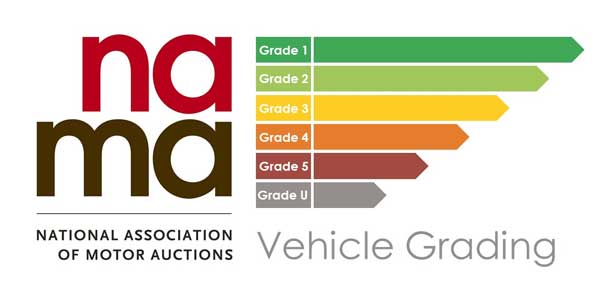The Letchworth Motor Auctions Inspection Grading System
The NAMA Grading Scheme for vehicles has been developed to enhance transparency and make it easier for auction buyers to select the vehicles they want to buy.
The scheme has 5 grades which are based on the external condition of a vehicle. The grades are determined on a points system allocated by type and severity of damage.
Grades are assessed by inspectors at each auction and our vehicle inspector specifically trained to grade vehicles and working to a strict standard.
Over 90% of vehicles sold at auction are currently graded. Since the scheme was first launched in excess of 10 million vehicles been given a grade.

Vehicle Grading Explained

Grade 1
The vehicle is generally in good condition for its age. Could include minor external defects like chips/scratches with minimum refurb required for retail standard. May have minor missing trim items.
- Minor repairs, for example, small dent without paint damage or touch in type repair
- Missing minor trim items, e.g. tow eye cover
Excludes:
- Any panels which require paint

Grade 2
The vehicle may require 1 medium bodyshop repair or a number of SMART repairs with a low level of repair work to bring to retail standard. May have a series of minor repairs and small missing components.
- 1 medium bodyshop repair or a combination of 1 medium bodyshop repair and several minor repairs
- May have up to 7 minor repairs or a combination of minor repairs and small missing components
Excludes:
- Any vehicle with more than 1 medium bodyshop repair

Grade 3
The vehicle will require some attention. Eg; multiple minor, or up to 4 medium bodyshop repairs (for example 1 bumper) and/or 3 major bodyshop repairs, alongside multiple SMART repairs.
- Up to 4 medium bodyshop repairs
- Could require a new bumper but not 2
- Up to 3 major bodyshop repairs

Grade 4
The vehicle will require multiple minors and/or up to 3 major bodyshop repairs (for example a panel), alongside multiple SMART repairs. Excludes major structural components such as roofs).
- A single major repair and some medium and/or minor repairs
Excludes:
- Major repairs to structural components; example roof of quarter repair
- More than 1 major repair

Grade 5
The vehicle requires significant attention; it will including multiple major bodyshop repairs (eg; after a collision) and/or SMART and/ minor repairs, could include repair to a structural panel.
- More than 2 major repairs
Excludes:
- More than 5 major repairs
- More than 2 structural repairs or 2 with any other damage
- Combination of all the above up to a total of 3500 points

Grade U (UNGRADED)
Vehicles in this grade are simply uneconomical to appraise including major parts missing, multiple unrecorded items, if points exceeding Grade 5 criteria, or it could be Grade U simply because of its age.
Benefits of Grading
Sellers
- A defined condition will promote the best possible price. The grade represents a defined condition which encourages buyers to bid with confidence. In the past, if there has been any aspect of a car’s condition that has aroused doubt in the mind of an intending buyer, then the bids were likely to reflect this
- Cars of specific grades will be attractive to certain buyers thereby helping to ensure that sellers attract the best audience for their cars
- The setting of reserve prices can be assessed more critically because more is known about the condition of individual cars. This will reduce the incidence of cars, either exceeding, or falling short of reserves, without apparent reason
- The adoption of condition values by the Guides will permit a more accurate comparison with either reserves being set, or the prices being achieved
- Provide a consistent, transparent grading of vehicles across different auction centres.
Buyers
- The consistent and transparent grading of vehicles across different auction centres allows buyers to target those cars that are of particular interest, saving valuable time in the process
- For individual sales buyers can easily and quickly identify those cars that are of interest
- Buyers will have more confidence to buy on-line in the knowledge that they are purchasing a car of a known condition
- The grading that is supported with a detailed vehicle inspection carried out by a trained inspector in appropriate weather conditions
Auction Houses
- With more certainty around condition, transactions between buyers and sellers can be conducted more efficiently. This is because the grade reduces condition ambiguities and possible disagreements
- Provides a role definition of competency framework for the recruitment and development of vehicle inspectors
- Provides a training resource for the training of vehicle inspectors
The aim of a standardised grading scheme is to provide structure, systems and training that remove some of the subjectivity that currently exists. A number of grading systems already exist but there is no standardised scheme and this makes it difficult for customers to compare.
The grading scheme is completely voluntary but has a wide take up within the auction sector.
